百舌鳥・古市古墳群ミステリー ~誰のお墓で、どんな人だった?~ The mystery of Mozu-Huruichi
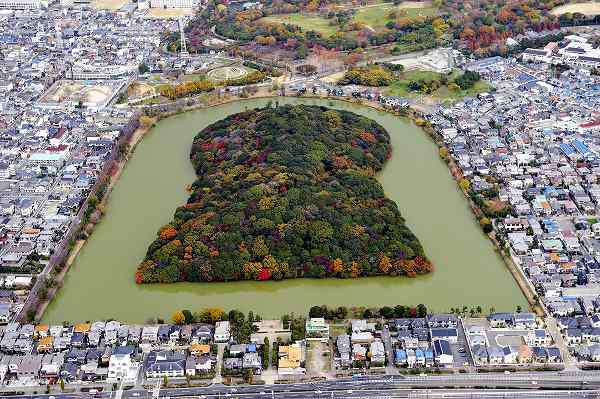
令和になって、2か月が過ぎようとしています。初めは馴染みのない呼び方に、戸惑いを感じた人も多かったでしょうが、最近はすっかり定着してきました。
本屋さんにいくと、令和という元号の由来である、『万葉集』が特設コーナーに置いてありました。
It’s been two month since the first year of Reiwa started.
At first, there were many people who felt puzzled by the unfamiliar calling of Reiwa,
but recently we became completely familiar with it.
When I went to the bookstore, “Manyoshu,” which is the origin of the name of Reiwa, was placed in the special corner.
普段は地味な古典文学のコーナーに置いてあるのですが、ここのところ、ここぞとばかりに目立つ場所に置かれて、なんだか令和☆『万葉集』祭りのよう(^^♪
Though Manyoshu can be found in classical literature corner, recently they are placed in good places to be seen here and there,
It seems like Reiwa “Manyoshu” festeval !
さて、早速『万葉集』の本を買ったあなた!
買っていないあなたもですよ!(笑)
Well, you who bought the book of Manyoshu right away or not !
『万葉集』の巻頭に載っている、記念すべき1番目の歌をご存知ですか?
実は7月に世界遺産に登録される、あの古墳群と関係あります!
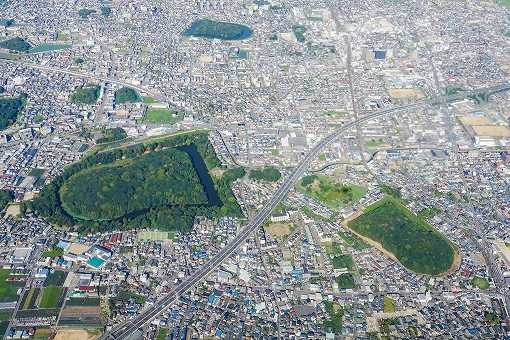
古市古墳群(藤井寺市提供)
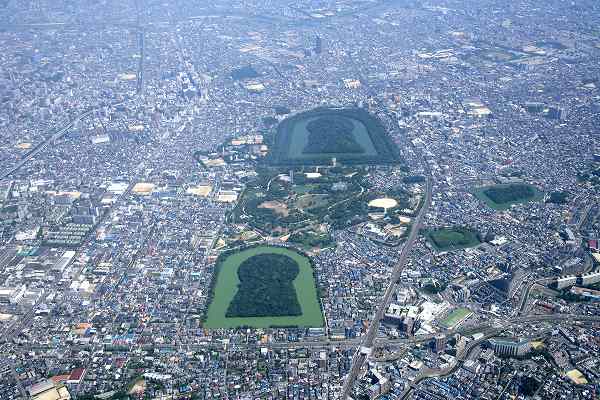
百舌鳥古墳群(堺市提供)
Do you know the first poem to commemorate, which was listed at the beginning of Manyoshu?
In fact, it is related to that old tomb group registered as a World Heritage Site in July!
百舌鳥・古市古墳群のなかに『万葉集』1番歌の作者とされる天皇の墓があるのですね。
There is the tomb of the Emperor, who is considered the author of the first poem of Manyoshu, among Mozu-Furuichi burial mounds.
万葉集巻頭歌
『万葉集』巻1・1番歌
大泊瀬稚武(雄略天皇)御製の歌
Manyoshu Vol. 1 ・ 1
Ohhastusewakatakeru (emperor Yuryaku)
籠(こ)もよ み籠持(こも)ち 掘串(ふくし)もよ み掘串持(ぶくしも)ち
この岳(おか)に 菜摘(なつ)ます兒(こ)
家聞(いえき)かな 告(の)らさね
そらみつ大和(やまと)の国は おしなべて我こそ居(お)れ
しきなべて 我(われ)こそ座(ま)せ
我こそは告(の)らめ 家をも名をも
現代語訳
美しい籠やヘラを持って、この丘で菜をお摘みのお嬢さん、君はどこの家のお嬢さんなのか教えてくれないか。大和の全てを私が治めているのだ。私こそ教えよう、家柄も名も。
Young lady Holding basket and scoop for young leaves on this hill,
please tell me your name and where you live in.Oh, this country ‘Yamato’ !
I am the ruler.I am the king of all this country.
I do tell you, my house and my name.
春になったのでしょうか、籠とヘラを持って、若菜摘みに出かけている少女に目が留まった大王は、次のように、呼びかけます。
Had spring come already?
The great king who found a girl who went out for young leaf-picking, holding a basket and a scoop, called her as follows.
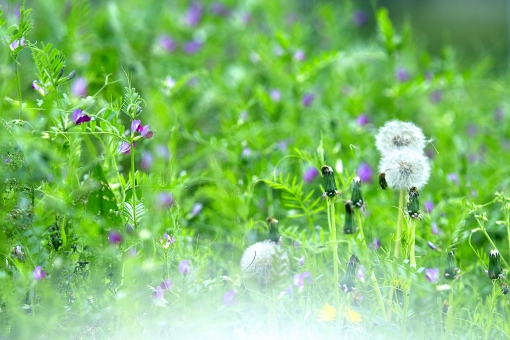
「この大和の国は私が治めているのだよ。お嬢さん。私にあなたの名前と家を教えて欲しい。いや、私こそ教えよう、私の家と名前を。」
“I am in control of this country of Yamato. Young lady.”I want you to tell me your name and house, or I will tell you, my house and name.“
実は古代において、家、名を尋ねるという行為は求婚の意味があったのですね。
ですから女性は簡単に自分の名を明かしませんでした。
人に自分の名前を知られる、ということは呪術的に人に支配されるということでした。
Actually, in ancient times, the act of asking for a house and a name had a meaning of courtship.
So women did not easily reveal their name.
The fact that someone knows your name means that it is magically ruled by them.
春の野にいる乙女に求婚する大王(天皇という呼称はこの時代まだない)という設定ではありますが、
実は大切なのは、次の一文、雄略自身の「我こそは告(の)らめ 家をも名をも」というセリフです。
Though it is a scene of the great king ( the emperor has not been called in this era yet ) to suit a girl in the spring field, actually the important line is the following, “I will tell you, my house and name” by Yuryaku himself.
実は、自分こそが大和の国の大王様だ!!という大きな宣言をしているのですね。
In fact, He made a big declaration of being the great king of the country of Yamato.
鮮烈でダイナミックな古代国家誕生の瞬間を『万葉集』は巻頭歌に載せています!
Manyoshu includes the start of the vivid and dynamic ancient nation’Yamato’ in the beginning of poetry!
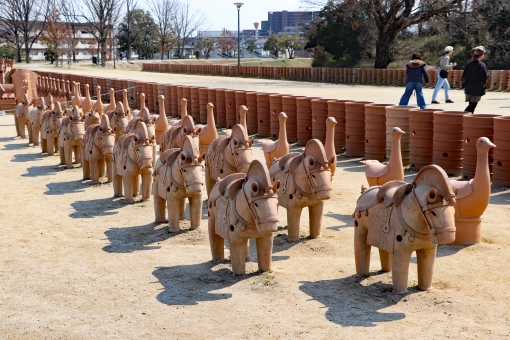
今城塚古墳の埴輪祭祀
倭の五王の時代 The age of the Five Kings of Yamato
古墳時代の中期は5世紀に当たりますが、歴史的に重要な転換点である、「倭の五王の時代」があります。
The middle of the Kofun period is the 5th century,This fifth century has a historically important turning point, “The Age of Five Kings of ancient japan”.
倭の五王とは、『宋書』倭国伝にその様子が伺えます。
倭国の特産品や贈り物を持参し、中国を訪れ、 将軍号・郡太守号などの称号を中華皇帝より認めてもらい、自らの権威を高めることが目的でした。
五王なので、5人います。
古いほうから年代順に並べますと、讃、珍、済、興、武になります。
The five kings of Wa( ancient Japan ), can be seen in the “Sojyo”(a Chinese history book) .
Their purpose were to raise their authority by receiving titles such as Shogun, Tamori of the country from Chinese emperor.
So they brought ancient Japanese specialties and gifts and visited China.
Because it says ‘five kings’, there are five people.
If they are arranged in chronological order, San, Chin, Sei, Ko, Bu.
これは『宋書』の中の人物名です。実際には彼らがどの大王なのか、それは議論が続いて決着がまだついていません・・・・。
They are the names of the characters in the “Sojyo the Chinese history”.
In fact, it is debated and it has not been settled yet which king they are …
五王の一番始めの「讃」は15代の応神天皇とする説や、16代仁徳天皇とする説があります。
There were theories that the first “San” of the Five Kings was the fifteenth emperor Ojin or the sixteenth emperor Nintoku.
応神天皇の墓は古市古墳群の最大古墳、誉田御廟山古墳に比定されています。
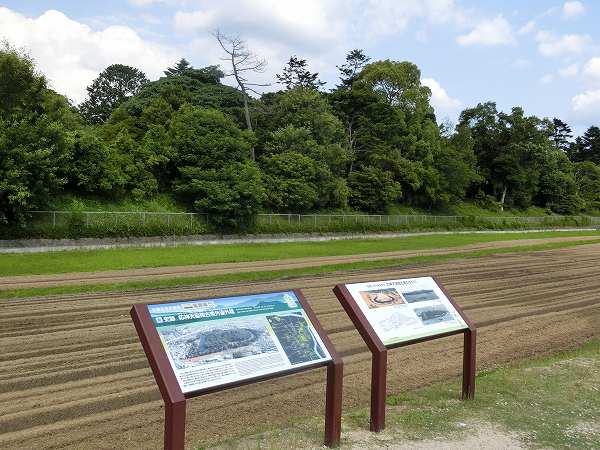
応神天皇陵(個人提供)
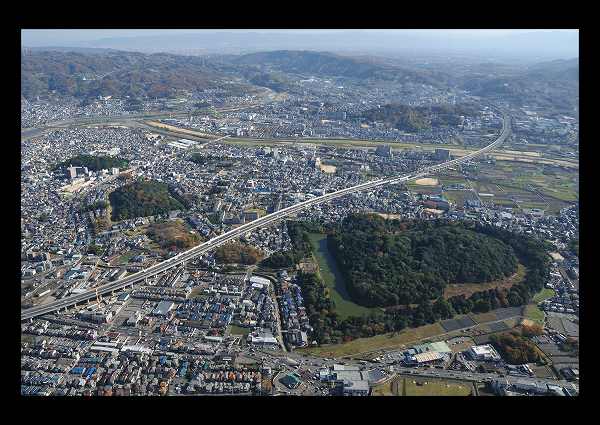
応神天皇陵 (藤井寺市提供)
仁徳天皇の墓は百舌鳥古墳群の最大古墳、大山陵古墳ではないか、と考えられています。
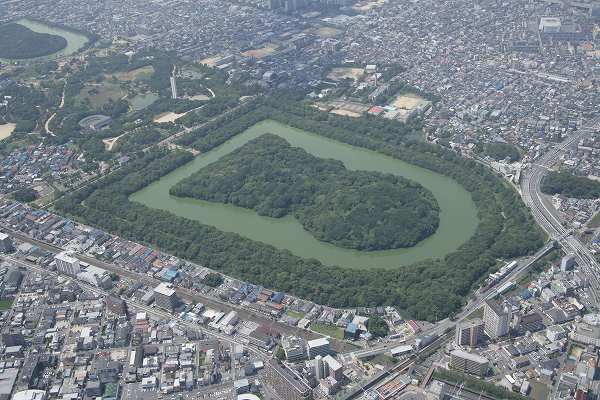
仁徳天皇陵(堺市提供)
Emperor Ojin’s tomb is identified as the largest burial mound ‘Konda-gojyozan kohun’ in Furuichi ancient tomb group.
It is believed that Emperor Nintoku’s tomb is the largest burial mound ‘Daisen-ryo kofun’ in the Mozu-kofun ancient tombs group.
一方で、倭の五王最後の王にあたる武は誰でしょうか?
これは、21代雄略天皇とする説が有力です。
On the other hand, who is ‘Bu’ who was the last king of the Five Kings of ancient Japan?
There is a poweful theory that ‘Bu’ assumes the 21st Emperor Yuryaku.
雄略天皇といえば、『万葉集』の巻頭を飾る大王宣言の歌ですね!
雄略の陵墓は古市古墳群にある 島泉高鷲古墳(高鷲平塚古墳)ではないか、とされています。
Speaking of the Emperor Yuryaku, threre is a poem of the Great King Declaration that was contained the beginning of “Manyoshu”!
It is said that his tomb is Shimaizumi-takawashi ancient burial tomb (Takawashi-hiratuka Tomb) in Furuichi ancient tomb Group.
実は倭の五王の時代は、そのまま百舌鳥・古市古墳群の時代に当てはまってしまうのです!
In fact, the age of the five kings of Ancient Japan applies to the age of the Mozu-Furuichi ancient tomb groups.
大王「雄略」の人物像 The figure of the great king ‘Yuryaku’
『古事記』をひも解くと、大王雄略の性格がわかるようなエピソードがあるのです。
その何点かをご紹介します。
When you open he pages “Kojiki”, there is an episode where you can understand the character of the Great King Yuryaku.
I will introduce some of them.
・自分が大王位を継ぎたいがため、ライバルを次々と殺害し、大王位を簒奪した。
・焼き殺す、追放する、斬る、など気に入らない臣下を抹殺した。
・侍女が杯をもって、雄略に捧げたときに、葉が舞い落ちて、杯に落ちた。
怒った雄略は侍女の首を切ろうとした。命乞いのために侍女は歌を歌った。
その歌がとても上手だったので、雄略は機嫌を直した。
・In order to become a great king,
he killed his rivals one after another and robbed the great throne.
・He slayed, burned, banished, killed, and killed the unpleasant vassal.
・When a waiting maid gave a cup to him, the leaves fell and fell into a cup. The angry king Yuryaku tried to cut the maid’s neck.
The maid sang a song to save he life.
Because the song was so good, he fixed his mood.
以上が恐ろしい彼の一面を表すエピソードです。
一方で、ちょっと微笑ましい?エピソードもあります。
The above is an episode representing his horrible side.
On the other hand, there were also a slightly smiley episodes.
・あるとき、雄略が外出したときに、川のほとりで衣服を洗う乙女にであった。その乙女にその場で求婚し、「あとで迎えに行くから」といっておきながら、その約束を忘れてしまった。
80年たち、雄略との約束をかたくなに守った乙女は、老婆になってしまった。
老婆になった乙女は雄略に会いにいき、80年前に求婚された乙女で、今も待っていたことを話した。
不憫に思った大王雄略は、その老婆に歌を贈った。
・葛城山に登ったとき、自分の行列とそっくりの行列を見つけた。
不審に思い、その行列を咎めたところ、葛城山の一言主大神の変身した姿だとわかった。
その一言主大神に対し衣服を献上し、敬った。
・One time, when he went out, he met a beautiful girl who was washing clothes by the river.
He asked the girl to marry him on the spot and said, “I’ll pick you up later.”
But he forgot the promise.
After 80 years, the girl who kept the promise with him became an old woman.The girl who became old woman went to see him.
She told that she was proposed 80 years ago and she had been waiting for him.
The Great King Yuryaku, who felt sorry for her, sent a poem to the old woman.
・When he climbed Mt. Kasturagi, he found a procession similar to his own procession.
He thought suspiciously and interrogated the procession, and found that it was a transformed figure of the god ‘Hitokotonushi’ of Mt.Katsuragi.
He presented clothes to the god ‘Hitokotonushi’of Mt.Katsuragi.
And he respected the god of Mt.Katsuragi.
まとめ Summary
この時代、大王や王族は大きな墓を作ってもらいました。
それは政治的な意味合いを十分含むものでありますが、あまりに巨大な古墳に埋葬されることは庶民ではとても叶わない、夢ですね。
During this time, the great kings and royalty made a large tomb.
Making a huge tomb has political implications.
Being buried in a huge tomb is a dream that the common people will never meet.
しかしながら、王族に生まれても決して幸せとは言えません。
倭の五王の雄略天皇の物語が示すように、王族に生まれても、命を奪われるような事件に遭遇することもあります。
彼の活躍した古墳時代の中期は、呪術より軍事力が重要視されたようです。
However, being born to a royal family can not be said to be happy at all.
As the story of 5 kings of ancient Japan shows, even if you are born to a royal family, you may encounter an incident that may be deprived of life.
In the middle of the Kofun period where he lived, it seems that military power was considered more important than old ancient magic.
古墳から出土する副葬品がそれを物語っています。
5世紀は、甲冑、兜、鉄製品などの戦いを連想させる副葬品が多く出土するようになりました。
これまでの「玉・鏡・剣」といった神器にとってかわっているのですね。
The burial goods excavated from the tombs tell it.
In the 5th century, many burial goods reminiscent of battles such as armor, helmet and iron products began to be excavated from ancient tombs.
They replace the traditional “balls, mirrors and swords”.
あれから1600年。古墳の世紀はすっかり様変わりし、倭国もありません。
けれど、百舌鳥古墳群は確かにその時代を私たちに伝えています。
It has been 1600 years since then.
The centuries of ancient tombs have changed completely, and there is no country of ancient Japan.However, Mozu ancient tombs grope certainly tells us that era.
たまには古墳散策をして、古代のミステリー探求もいいかもしれません。
Sometimes It may be good to go around the ancient tombs and explore the ancient mystery for you.
コメント
この記事へのトラックバックはありません。



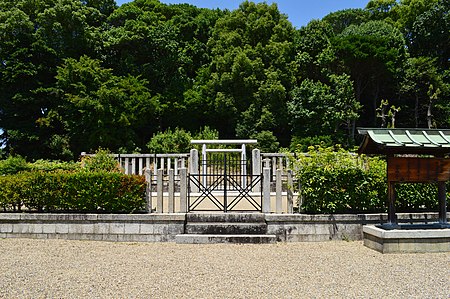
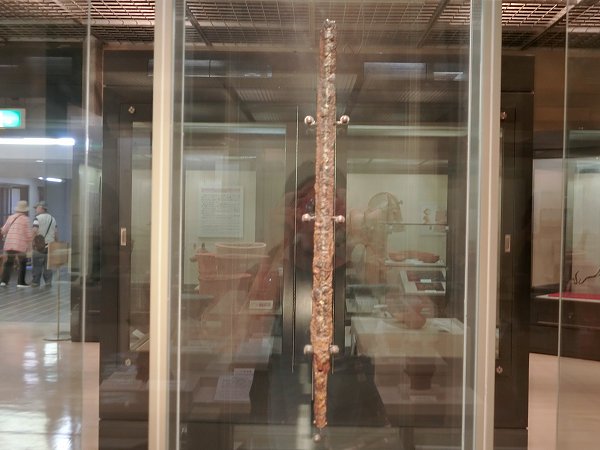
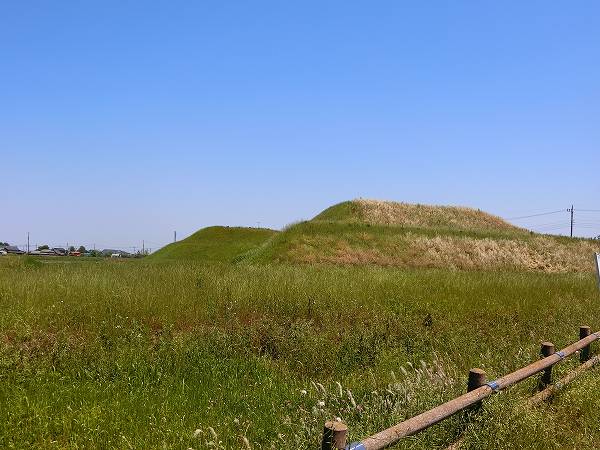
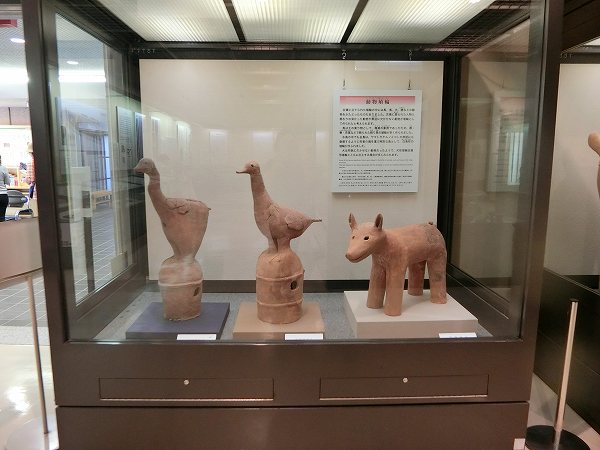
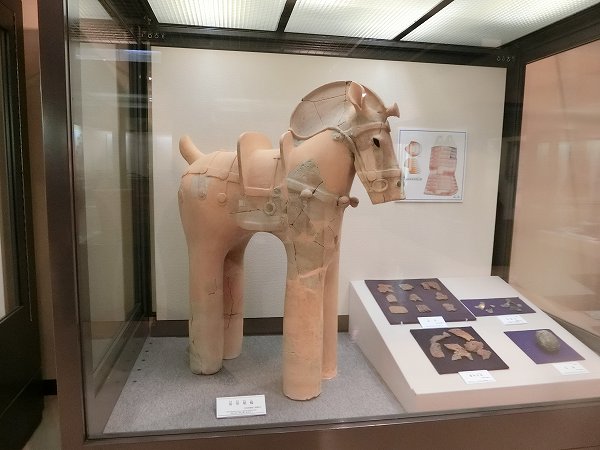

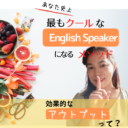

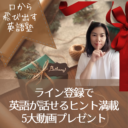



この記事へのコメントはありません。